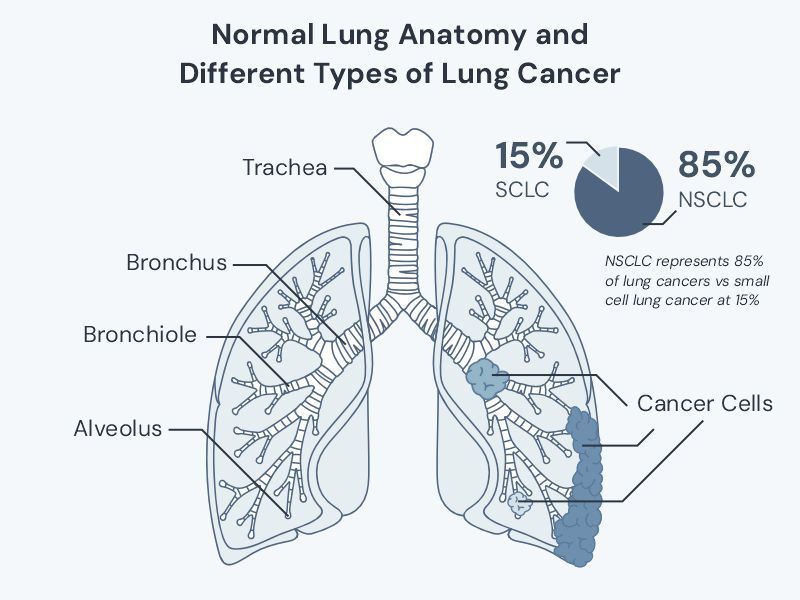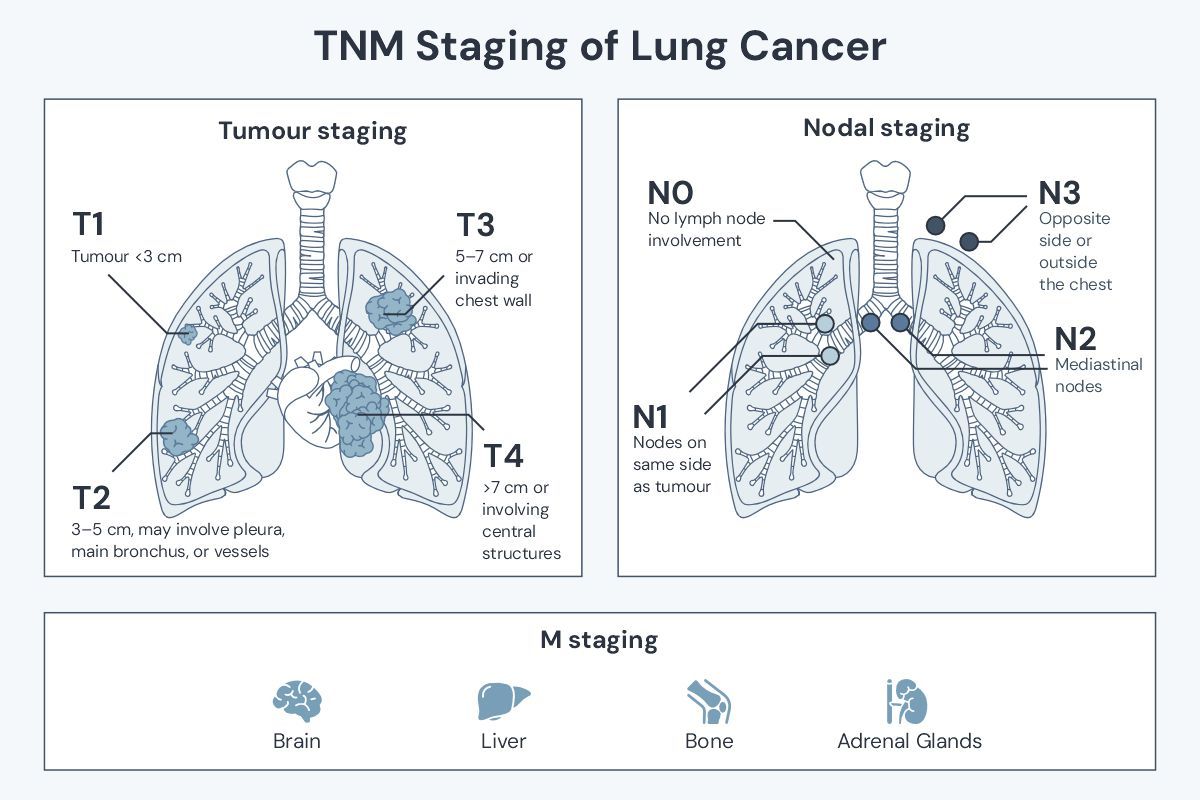What is Lung Cancer? Types, Stages, and Treatments
Lung cancer develops when abnormal cells in the lungs begin to multiply uncontrollably, forming a tumour that can spread to other parts of the body if left untreated.


Jump to:
- Key takeaways
- Overview of lung cancer
- The importance of early lung cancer detection
- Types of lung cancer
- Non-Small Cell Lung Cancer (NSCLC)
- Adenocarcinoma
- Squamous cell carcinoma
- Large cell carcinoma
- Small Cell Lung Cancer (SCLC)
- Stages of lung cancer
- Stage 1: Early stage
- Stage 2: Local spread
- Stage 3: Locally advanced
- Stage 4: Metastatic
- Symptoms of lung cancer
- The most common symptoms of lung cancer are:
- Concerned about lung cancer
- Diagnosis of lung cancer
- Diagnostic methods
- Bronchoscopy
- Biopsies and tests
- Imaging tests
- Role of staging in lung cancer
- Treatment options for lung cancer
- Surgery
- Chemotherapy
- Radiotherapy
- Stereotactic Radiotherapy (SABR or SBRT) for lung cancer
- Stereotactic Radiotherapy - Treating Oligometastatic Lung Cancer
- Intensity-Modulated Radiotherapy (IMRT)
- Radiotherapy for Symptom Control
- Targeted Therapies
- Immunotherapy
- Combination Approaches
- Advanced Treatment Options
- Proton Beam Therapy (PBT)
- MR-linac treatment
- Benefits of innovative therapies
- Frequently asked questions
- What are the main treatment options for lung cancer?
- If I have surgery for my lung cancer, can I avoid chemotherapy and radiotherapy?
- If I have chemotherapy or radiotherapy, can I avoid surgery?
- How does radiotherapy work for lung cancer?
- What is SABR, and how is it different from traditional radiotherapy?
- What is the success rate of lung cancer radiotherapy?
- Will I die from lung cancer?
Key takeaways
-
Lung cancer develops when abnormal cells in the lungs grow uncontrollably
-
Early detection significantly improves treatment outcomes
-
Lung cancer is the leading cause of cancer death in the UK
-
There are two main types: non-small cell lung cancer (NSCLC) and small cell lung cancer (SCLC)
-
Advanced treatment options include surgery, chemotherapy, radiotherapy, immunotherapy, and targeted therapies
-
Cutting-edge treatments like proton beam therapy and MR-linac offer new hope for patients
Overview of lung cancer
Lung cancer develops when abnormal cells in the lungs begin to multiply uncontrollably, forming a tumour that can spread to other parts of the body if left untreated. As one of the most common cancers in the UK, it affects thousands of people each year, but significant advances in early detection and treatment are improving outcomes for patients.
While smoking remains the primary risk factor for lung cancer, accounting for about 85% of cases, it's important to understand that non-smokers can develop the disease too. We know that tobacco smoke causes lung cancer. Other risk factors include exposure to secondhand smoke, radon gas, asbestos, air pollution, and family history of lung cancer.
Early detection is crucial for successful treatment. If you experience persistent symptoms such as a lingering cough, coughing up blood, chest pain, breathlessness, or unexplained weight loss, seek medical advice promptly. These symptoms often appear only when the cancer is advanced, making regular check-ups vital for those at higher risk.
The importance of early lung cancer detection
Early detection of lung cancer is crucial because it significantly improves treatment outcomes and survival rates. Lung cancer treatments like surgery, radiotherapy, immunotherapy, targeted therapies, and clinical trials—or different combinations of these approaches—are more successful when used in the early stages.
If you are over 55 and your lungs have been exposed to tobacco smoke, you may be called for lung cancer screening. This gives the potential for early detection which makes curative treatment more likely. Screening scans also gives other types of lung health information.
Ultimately, your treatment choices for lung cancer are influenced by the cancer type, its stage, your overall health, and your personal preferences for your cancer care. Treatment of secondary lung cancer is discussed elsewhere.
Types of lung cancer

Non-Small Cell Lung Cancer (NSCLC)
Non-small cell lung cancer accounts for approximately 80-85% of all lung cancers. It typically grows and spreads more slowly than small cell lung cancer, which can influence treatment approaches. NSCLC includes several subtypes based on the type of cell where there cancer started:
Adenocarcinoma
Lung adenocarcinoma is the most common type of lung cancer, particularly among non-smokers, women, and younger patients. It typically develops in the outer regions of the lungs and may cause symptoms later than other types.
Squamous cell carcinoma
Usually linked to smoking, squamous cell carcinoma forms in the cells lining the main airways (bronchi) and tends to be located centrally in the lungs. It accounts for about 25-30% of all lung cancers.
Squamous cell carcinoma starts in squamous cells, flat cells that line the inside of the lungs' airways. It is often linked to a history of smoking and tends to be found in the central part of the lungs, near a main airway (bronchus).
Large cell carcinoma
Large cell carcinoma is a very uncommon type of cancer that can appear in any part of the lung. It tends to grow and spread quickly.
Small Cell Lung Cancer (SCLC)
Small cell lung cancer represents about 15-20% of lung cancers and is almost always associated with smoking. This type of lung cancer grows rapidly and often spreads to other parts of the body before diagnosis, requiring prompt and aggressive treatment approaches.
Treatment includes chemotherapy and radiation therapy.
Stages of lung cancer
The stage of cancer describes how much and where it is in the body. It also helps us to determine the best treatment options. As a rule, the lower the number, the less the cancer has spread.
Understanding the stage of lung cancer is crucial for determining the most appropriate treatment plan:
Stage 1: Early stage
The cancer is small (usually under 4 cm) and confined to the lung without spreading to nearby lymph nodes. Surgery or precise radiation treatment (like SABR/SBRT) often offers a good chance of cure at this stage.
Stage 2: Local spread
Stage 2 lung cancer, typically also called early-stage lung cancer, means the lung cancer has grown larger or spread or progressed to nearby lymph nodes. Lung cancer spreads to lymph nodes early and can still often be treated with the aims of cure.
Stage 3: Locally advanced
The cancer has spread more extensively within the chest, potentially involving structures like the heart, major blood vessels, chest wall or lymph nodes in the chest. Treatment often combines radiotherapy with chemotherapy, sometimes followed by immunotherapy.
Stage 4: Metastatic
Stage 4 lung cancer has spread beyond the chest to distant organs such as the brain, bones, liver, or adrenal glands. Lung cancer spreads through the blood stream or lymphatic systems. Treatment at this stage focuses on controlling the disease and managing symptoms through various combinations of targeted therapy, immunotherapy, chemotherapy, and radiotherapy.
Fluid around the lung, called a pleural effusion, also defines Stage 4 lung cancer.
For a more detailed discussion on lung cancer staging, read a comprehensive discussion here.

Symptoms of lung cancer
Lung cancer often presents no symptoms in its early stages, but early detection of lung cancer can mean that it's easier to treat. So if you notice any symptoms or changes, consult your doctor as soon as possible.
The most common symptoms of lung cancer are:
-
Having a new cough or a cough most of the time that has lasted for 3 weeks
-
Shortness of breath when doing the things you used to do without a problem
-
Coughing up blood
-
Having chest pain or continuous shoulder pain
-
Chest infections that keep coming back or that don't get better
-
Feeling tired all the time
-
Loss of appetite and weight loss
Concerned about lung cancer
If you experience any of these lung cancer symptoms, especially if you're at higher risk due to smoking history or other factors, consult your GP promptly. Early detection significantly improves treatment outcomes. Don't delay seeking medical attention because of worry or fear, timely diagnosis can be life-saving.
If you find yourself googling questions like 'What are the signs and symptoms of lung cancer?' or 'Do I have lung cancer quiz?' you should probably speak to your doctor about your concerns. Both the NHS and private hospitals offer lung cancer screening to those most at risk.
Diagnosis of lung cancer
Diagnostic methods
Medical history and physical examination
Your doctor will ask about your medical history to understand your symptoms and identify potential risk factors. These risk factors and known causes of lung cancer could include a family history of lung cancer, smoking or exposure to secondhand smoke, exposure to radon gas, asbestos exposure and a history of respiratory conditions. Additionally, your doctor will examine you to check for indications of lung disease.
If the results of your history and physical exam suggest you might have lung cancer, your healthcare professional will recommend more tests. These could include lung cancer screening, such as a bronchoscopy, imaging tests, and/or biopsies.
Bronchoscopy
Bronchoscopy is a minimally invasive procedure used to diagnose issues pertaining to the lungs or airways. Healthcare professionals use a bronchoscope to examine the windpipe and lungs. They may also obtain a tissue sample or a sample of a lung nodule for laboratory analysis.
Biopsies and tests
Lung cells may be taken via a needle or surgical procedure (needle biopsy), fluid can be extracted from the lung (thoracentesis), or lung secretions (mucus coughed up from the lungs) can be analysed. The selection of tests depends on the different types of lung cancer being tested for. Endobronchial ultrasound (EBUS): Combines bronchoscopy with ultrasound to locate and sample lymph nodes
Imaging tests
Imaging tests, such as chest X-rays, magnetic resonance imaging (MRI scan), or computed tomography (CT scan), create pictures of the inside of your body. Imaging tests may be conducted for a number of reasons, both before and after a lung cancer diagnosis or following lung cancer treatment. Positron emission tomography (PET-CT scan) helps determine if the cancer has spread beyond the lungs.
Role of staging in lung cancer
When I look at staging, I consider the size of the tumour and whether it has spread to nearby areas or other parts of the body, such as lymph nodes or organs. With this information, I can then select the best treatment options for you.
Accurate staging is essential for developing the most effective treatment plan. Staging considers the size of the tumour, lymph node involvement, and whether the cancer has metastasised. This information helps determine whether treatment should focus on cure or controlling the disease to extend life and manage symptoms.
Treatment options for lung cancer
The treatment options for each type and stage of lung cancer differ, and I will always discuss the best choices for lung cancer treatment by considering your specific cancer type, its stage, your overall health, and your own treatment decisions.
Surgery
Surgical treatment for early-stage lung cancer typically involves removing the tumour along with a portion of surrounding lung tissue and often nearby lymph nodes. This treatment option is considered most effective when the lung cancer is localised, early stage and has not spread to other parts of the body.
It's important to remember that whether your lung cancer is confined as a lung tumour, is early stage or has spread to an advanced stage, with targeted therapy, there is always something I can do to help.
Chemotherapy
Chemotherapy remains a cornerstone in the effective treatment of lung cancer. It works by killing rapidly dividing cancerous cells throughout the body.
Each chemotherapy treatment option is part of a larger strategy to provide you with the best possible outcome. As one of the few UK cancer doctors with access to all of the new lung cancer treatments, I am here to offer progressive cancer support.
Chemotherapy uses drugs to kill cancer cells throughout the body. It may be given:
-
Before surgery (neoadjuvant) to shrink tumours
-
After surgery (adjuvant) to eliminate remaining cancer cells
-
As primary treatment for advanced cancer
-
In combination with radiotherapy (chemoradiotherapy) for locally advanced disease
Radiotherapy
I specialise in state-of-the-art lung cancer treatment therapies that offer powerful alternatives to surgery.
Conventional radiotherapy delivers radiation to the tumour while minimising exposure to healthy tissue. It may be used after surgery to eliminate remaining cancer cells or as the main treatment when surgery isn't an option.
Stereotactic Radiotherapy (SABR or SBRT) for lung cancer
Stereotactic radiotherapy (SABR) is a precise, high-dose radiation therapy for early-stage lung cancer. It’s highly effective, and my personal cure rate is 90%. Side effects are less common with SABR, helping maintain your quality of life and overall health.
SABR to treat lung cancer requires fewer hospital visits than standard radiotherapy—typically, a treatment plan is 3-5 outpatient sessions, sometimes just one.
Using advanced image-guided techniques, I can treat cancers near the heart, oesophagus, or main airways that, due to increased risk, some centres can’t. If you’re in this situation, please contact me.
Stereotactic Radiotherapy - Treating Oligometastatic Lung Cancer
Oligometastatic cancer refers to the spread of lung cancer from its primary location to a few other parts of the body, typically up to five spots. Common areas include the brain, bones, liver, and other parts of the lung. I also offer stereotactic radiosurgery (SRS) for brain metastases. This non-invasive treatment is highly effective at controlling or eliminating brain tumours.
Oligoprogressive cancer occurs when most of the cancer responds well to drug treatment, but a few spots begin to grow again.
In both scenarios, I use SABR to target these limited areas. This approach aims to continue your current drug treatment for as long as possible, delaying the need to switch to other cancer-controlling options.
Intensity-Modulated Radiotherapy (IMRT)
IMRT (or Volumetric Arc Therapy - VMAT) is a modern approach to delivering conventional radiotherapy for lung cancer treatment.
I frequently use IMRT for patients with locally advanced lung disease, which involves larger tumours or cancer that has spread within the chest. To optimise your chance of being cured, I typically combine this treatment with chemotherapy, followed by immunotherapy.
Radiotherapy for Symptom Control
Even if lung cancer has spread outside of the chest (Stage 4 or metastatic lung cancer), radiotherapy provides significant benefits alongside drug treatments such as chemotherapy and immunotherapy.
The radiotherapy I provide effectively alleviates symptoms such as pain, bleeding, and cough. Furthermore, if your lung cancer diagnosis indicates the cancer has spread to the spine, radiotherapy can help reduce symptoms, maintain your mobility and quality of life.
Targeted Therapies
Targeted lung cancer treatments block specific genetic mutations or proteins that drive cancer growth. For patients with certain genetic changes in their tumours (such as EGFR, ALK, ROS1, or KRAS mutations), targeted therapies can be highly effective with fewer side effects than traditional chemotherapy.
These therapies are particularly effective for certain types of lung cancer, especially non-small cell lung cancer treatment (NSCLC).
I use targeted therapies, such as Tyrosine Kinase Inhibitors (TKIs, e.g., Osimertinib, Alectinib, and Sotorasib) to address particular genetic mutations or proteins responsible for lung cancer growth. A precision medicine strategy enables a more effective treatment plan with potentially fewer side effects.
Immunotherapy
Immunotherapy is one of the most exciting advancements in lung cancer treatment because it offers a targeted and effective treatment approach by boosting the immune system’s ability to recognise and attack cancer cells.
This breakthrough treatment helps your immune system recognise and attack cancer cells. Immunotherapy has revolutionised treatment for advanced lung cancer, sometimes providing long-term disease control even in metastatic disease. It may be used alone or in combination with chemotherapy or radiotherapy.
When necessary, I might integrate immunotherapy with other chemotherapy approaches to enhance the effectiveness of treating your lung cancer and improving your overall health.
Combination Approaches
Combination approaches for lung cancer treatment involve using a combination of different treatment options—surgery, radiation, chemotherapy, immunotherapy, and targeted therapy—to target the cancer from multiple angles and potentially improve lung cancer treatment outcomes. This treatment plan is often more effective than a single treatment and helps prevent cancer cells from developing resistance.
For example, chemoradiotherapy followed by immunotherapy has significantly improved survival rates for stage 3 lung cancer.
Advanced Treatment Options
Advanced lung cancer treatment primarily focuses on slowing the progression of the disease, relieving lung cancer symptoms, and enhancing quality of life. These treatments typically include chemotherapy, radiotherapy, targeted therapies, immunotherapy, and possibly surgery for palliative care purposes.
Proton Beam Therapy (PBT)
Proton beam therapy (PBT) is a specialised radiotherapy that more accurately targets lung cancer tumours, reducing radiation to essential organs, tissues, and associated parts of the body.
Proton beam therapy is especially beneficial for young people, lung tumors near vital organs, those previously treated with chest radiotherapy, or those with certain pre-existing lung conditions. Allowing me to offer curative lung cancer treatment to patients who’ve been treated before or declined for radiotherapy elsewhere.
Proton therapy has also shown promising outcomes. Compared to traditional radiotherapy, it has excellent survival rates and lower rates of side effects.
I treat my patients at a central London PBT centre and receive referrals nationally and internationally. We can arrange nearby accommodation for those requiring lung cancer treatment and travelling to London.
MR-linac treatment
MR-Linac therapy
The MR-Linac represents a significant leap forward in radiotherapy lung cancer treatments. It combines high-resolution MRI scanning with extremely precise radiation delivery, allowing real-time imaging during treatment. This technology enables precise tracking of the tumour as it moves during breathing, ensuring accurate treatment delivery while protecting surrounding healthy tissue.
I offer stereotactic radiotherapy using the MR-Linac and CyberKnife for primary lung cancers as well as for metastatic disease in the lung, lymph nodes, bones, spine, liver and other tissues. Stereotactic radiotherapy provides a greater likelihood of successfully eradicating cancer in 1 to 8 sessions; traditional radiation therapy typically necessitates daily treatments over 6 weeks.
MR-linac combines an MRI scanner with a linear accelerator, allowing real-time imaging during treatment. This technology enables precise tracking of the tumour as it moves during breathing, ensuring accurate treatment delivery while protecting surrounding healthy tissue.
Benefits of innovative therapies
Innovative lung cancer treatment therapies bring many benefits, including increased survival rates, a reduced risk of recurrence, and an overall improved quality of life.
Exciting options for lung cancer treatment, including immunotherapies, targeted therapies, and precision medicine, are paving the way for a curative approach to lung cancer treatment.
Frequently asked questions
What are the main treatment options for lung cancer?
Treatment options for lung cancer include surgery, radiation therapy, chemotherapy, targeted therapy (such as proton beam therapy or MR-linac) and immunotherapy.
Your lung cancer treatment options will depend on the type and stage of your lung cancer, your overall health.
If I have surgery for my lung cancer, can I avoid chemotherapy and radiotherapy?
Your treatment plan largely depends on the stage of your lung cancer and surgical outcomes. We may suggest chemotherapy, radiotherapy, or targeted therapies following surgery, depending on the stage of your lung cancer and its genetic characteristics.
If I have chemotherapy or radiotherapy, can I avoid surgery?
We’ll discuss the overall aim of your treatment before we begin. If you receiveSABR for early-stage lung cancer, your treatment is considered complete as soon as it concludes.
Chemoradiotherapy is administered with the goal of curing stage 3 lung cancer, and while I don’t routinely refer patients for surgery after chemoradiotherapy, if I see a potential advantage in surgery, I’ll discuss this with you.
Occasionally, I recommend chemotherapy and immunotherapy before surgery or chemotherapy or targeted therapies following surgery or radiotherapy.
How does radiotherapy work for lung cancer?
Radiotherapy uses high-energy radiation therapy to kill lung cancer cells or shrink tumours. It can be used alone or in combination with other treatments.
What is SABR, and how is it different from traditional radiotherapy?
Stereotactic Ablative Radiotherapy (SABR) is a highly precise form of radiation therapy that delivers high doses of radiation to a small, targeted area, minimising exposure to surrounding healthy tissues.
You’ll feel well enough to travel and can drive during and after your stereotactic radiotherapy lung cancer treatment.
What is the success rate of lung cancer radiotherapy?
The success rate of radiotherapy for lung cancer varies based on the stage and type of cancer, as well as the patient’s overall health. SABR has a high cure rate for early-stage lung cancer.
Will I die from lung cancer?
Survival rates after treatment for lung cancer vary widely. From my personal figures, 90% of the patients I have treated with SABR for early-stage lung cancer were cured by the treatment.
For patients with Stage 3 lung cancer with chemoradiotherapy followed by immunotherapy, the chance of being alive 5 years after treatment is currently about 40%. However, treatments for lung cancer are always improving, so I expect this figure to continue to improve.
In cases of metastatic lung cancer, I see patients who have responded remarkably well to treatment options, maintaining stability with controlled lung cancer treatments, many months or even years post-diagnosis.
Lung cancer treatment has undergone remarkable advancements in recent years, with innovative approaches offering new hope for patients at all stages. From precise surgical techniques to cutting-edge radiotherapy and breakthrough drug treatments, the options for effectively treating lung cancer continue to expand.
The key to successful treatment remains early detection. If you're experiencing concerning symptoms or are at high risk for lung cancer, seeking prompt medical advice is crucial. Remember that even advanced lung cancer has more treatment options than ever before, with therapies that can extend life while maintaining quality of life.
Contact us today to discuss your lung cancer diagnosis and explore advanced treatment options tailored to you.
If you'd like to receive Dr Wilson's comprehensive guide to lung cancer and its' treatment, please click here.
